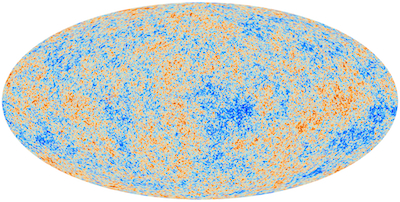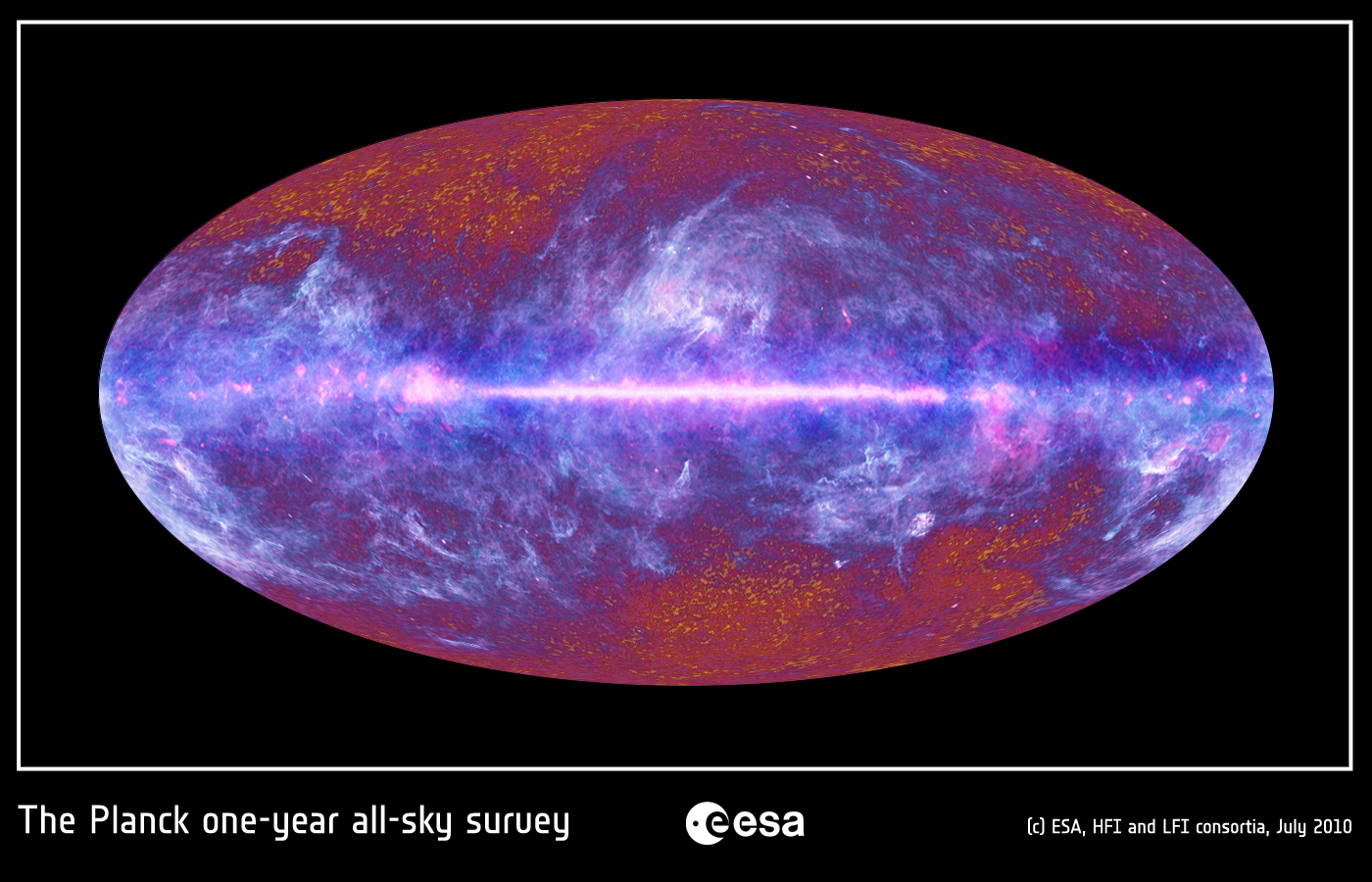Planck receives its final command
23rd October 2013

The Planck map of the Cosmic Microwave Background. Full resolution version.
Image Credits: ESA, LFI and HFI Consortia (2013)

A false-colour image of the whole sky as seen by Planck. The dust throughout the Galaxy (as seen by HFI) is shown in blue, while hot gas (as measured by LFI) can be seen as red regions across the centre of the image. In the background, the mottled yellow features are relic radiation, called the Cosmic Microwave Background, which contains information about the earliest stages of the Universe. This image is a low-resolution version of the full data set.
Image Credits: ESA, LFI and HFI Consortia (2010)
Europe's Planck satellite has been turned off after nearly 4.5 years of soaking up the relic radiation from the Big Bang and studying the formation of stars and galaxies throughout fourteen billion years of cosmic history.
Since its launch in 2009, Planck has been mapping the entire sky to observe the afterglow of the Big Bang - the Cosmic Microwave Background. This relic radiation reveals the Universe as it was 380,000 years after it began, and contains clues about the first moments of the cosmos.
Dr Chris Castelli, Acting Director of Science, Technology and Exploration at the UK Space Agency, said, "We're immensely proud to have played a key role in this amazing discovery machine. With its ability to make such detailed and accurate observations, Planck has found some of the missing pieces of a jigsaw that will eventually reveal a full picture of the evolution of our Universe."
The final command to the satellite was sent this afternoon by mission controllers at the European Space Agency's operations centre in Darmstadt, Germany. The instruments and cooling systems were turned off a few days ago, and the final instructions sent today asked the satellite to use up the last bit of fuel on board and turn off its transmitter.
The mission began drawing to a close in August, when the satellite was nudged away from its operational orbit around the Sun–Earth ‘Lagrange 2’ point towards a more distant long-term stable parking orbit around the Sun.
Planck and its two instruments operated successfully in space for over four years, scanning the sky at nine different colours of microwave light.
While Planck operated successfully in space for over four years, the full history of the mission is much longer. Since its conception, UK scientists have played a key role in the mission, working with colleagues from the rest of Europe and around the world.
“Those of us who built the hardware for Planck have been working on the mission for the best part of 20 years,” comments Prof. Richard Davis OBE, University of Manchester, who led the UK's involvement in Planck's Low Frequency Instrument (LFI). “It is a tribute to ESA and the many countries and even continents that have contributed to this successful project.” he continues.
“We started designing the High Frequency Instrument (HFI) in 1992 with our French and US colleagues, and produced the cryogenic detectors cooled to 0.1 degrees above absolute zero to provide it with exquisite sensitivity,” says Prof. Peter Ade, of Cardiff University. “The Planck satellite fulfilled its task in providing cosmologists with a reference set of 'text book' data on the state of the early Universe, which are proving to be an invaluable resource for other astronomers.”
Planck’s innovative cooler, reaching -273.05 Celsius, prevented the cosmic signals from being swamped by the heat from the satellite itself, allowing Planck to distinguish temperatures of a few millionths of a degree in the Cosmic Microwave Background. By scanning narrow strips around the sky over six months per survey, Planck was able make a complete sky map.
The original target was to complete two full surveys but the mission managed to make five full surveys with both instruments before HFI's helium coolant was exhausted in January 2012.
“Planck continued using LFI right up until last week, exceeding all expectations and providing us with bountiful data to work with in the future,” says Jan Tauber, ESA’s Planck project scientist.
As well as insights about the origins of structure in the Universe, Planck has provided exquisite views of material in the foreground. From the formation of stars in our galaxy, to catalogues of previously unknown clusters of distant galaxies, such material is a treasure trove for astronomers everywhere.
“Planck's real power is that it allows us to separate the light from our galaxy and all the other intervening matter from the glow of the CMB,” explains Prof Andrew Jaffe, Imperial College London. “It is this map of the early Universe which allows us to uncover the secrets of the cosmos.”
The first maps of the CMB were released earlier this year, based on just some of the Planck data, and refined the measurements of the age and composition of the Universe as well as revealing clues about the first moments of the Universe's existence.
“Planck has given us a fresh look at the matter that makes up our Universe and how it evolved, but we are still working hard to further constrain our understanding of how the Universe expanded from the infinitely small to the extraordinarily large, details which we hope to share next year,” concludes Dr Tauber.
Notes for Editors:
Further information
UK involvement in Planck
The UK is playing a major role in the Planck mission. A number of UK institutes and companies form part of the consortium that built the two focal plane instruments, HFI and LFI. The Jodrell Bank Observatory at The University of Manchester produced critical elements of the LFI receiver modules. Cardiff University, STFC RAL and SEA were involved with hardware development for HFI, while various UK research groups including Imperial College London, University of Cambridge, and University of Oxford form the London Planck Analysis Centre and Cambridge Planck Analysis Centre. These groups are involved with data analysis and simulation for the HFI data analysis and simulation software
Jodrell Bank's role in Planck
Jodrell Bank Centre for Astrophysics (JBCA) is directly involved with the two lowest frequencies of the Low Frequency Instrument, the 30 and 44 GHz radiometers. These have 4 and 6 detectors respectively, operating at 20K (-253.15°C or -423.67°F). The resolution on the sky is 33 and 27 arc minutes, and the sensitivity 1.6 and 2.4 micro K (over 12 months). The cryogenic low noise amplifiers which are the heart of the radiometers were developed at Jodrell Bank, with help from the National Radio Astronomy Observatory in Virginia, USA.
Dr B. Maffei and Dr G. Pisano are involved in the other focal instrument, the HFI. First at Cardiff University and now at the University of Manchester, they have played a major role in the design, development and calibration of the Focal Plane Unit, in particular the cold optics, in collaboration with the Institut d'Astrophysique Spatiale - France, Maynooth University - Ireland and JPL/Caltech - USA.
The work to understand the Galactic emission seen by Planck is being co-led from Jodrell Bank by Emeritus Professor Rod Davies and Dr Clive Dickinson. A number of projects are led by Jodrell Bank scientists, including Professor Richard Davis and Dr Clive Dickinson. Each of the 14 projects focusses on one aspect of the Galaxy as seen by Planck, including the electrons that gyrate in the Galactic magnetic field, the ionized gas that pervades the interstellar medium and the dust grains that emit across the entire frequency range that Planck is sensitive to. Jodrell Bank is also leading the calibration and identifying systematics in the LFI data.
Planck all-sky image and the CMB
The all-sky picture is of the oldest light in our Universe, imprinted on the sky when it was just 380 000 years old.
At that time, the young Universe was filled with a hot dense soup of interacting protons, electrons and photons at about 2700ºC. When the protons and electrons joined to form hydrogen atoms, the light was set free. As the Universe has expanded, this light today has been stretched out to microwave wavelengths, equivalent to a temperature of just 2.7 degrees above absolute zero.
This ‘cosmic microwave background’ – CMB – shows tiny temperature fluctuations that correspond to regions of slightly different densities at very early times, representing the seeds of all future structure: the stars and galaxies of today.
According to the standard model of cosmology, the fluctuations arose immediately after the Big Bang and were stretched to cosmologically large scales during a brief period of accelerated expansion known as inflation.
Planck was designed to map these fluctuations across the whole sky with greater resolution and sensitivity than ever before. By analysing the nature and distribution of the seeds in Planck’s CMB image, we can determine the composition and evolution of the Universe from its birth to the present day.
Planck data
The new data from Planck are based on the first 15.5 months of its all-sky surveys. Launched in 2009, Planck was designed to map the sky in nine frequencies using two state-of-the-art instruments: the Low Frequency Instrument (LFI), which includes the frequency bands 30–70 GHz, and the High Frequency Instrument (HFI), which includes the frequency bands 100–857 GHz. HFI completed its survey in January 2012, while LFI continues to operate.
Planck’s first all-sky image was released in 2010 and the first scientific data were released in 2011. Since then, scientists have been extracting the foreground emissions that lie between us and the Universe’s first light to reveal the CMB presented in the 2013 data release. The next set of cosmology data will be released in early 2014.
Contacts
Prof. Richard Davis
The University of Manchester
Tel: +44 (0)161 275 4164.
Julia Short
Press Officer
UK Space Agency
Tel: +44 (0)1793 418069
Mobile: +44 (0)7770 276721
Email: julia.short@ukspaceagency.bis.gsi.gov.uk


